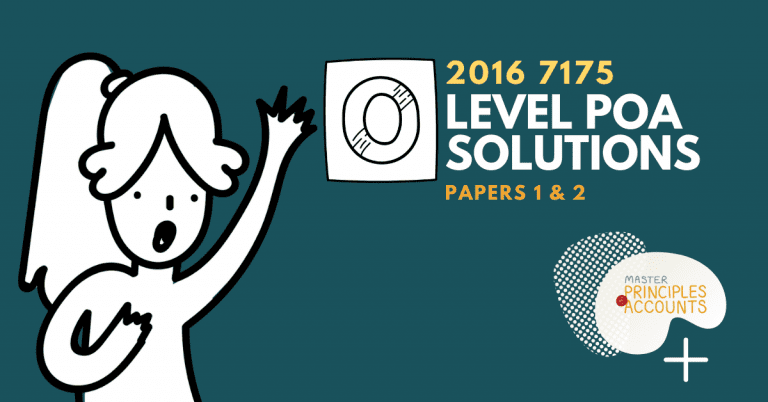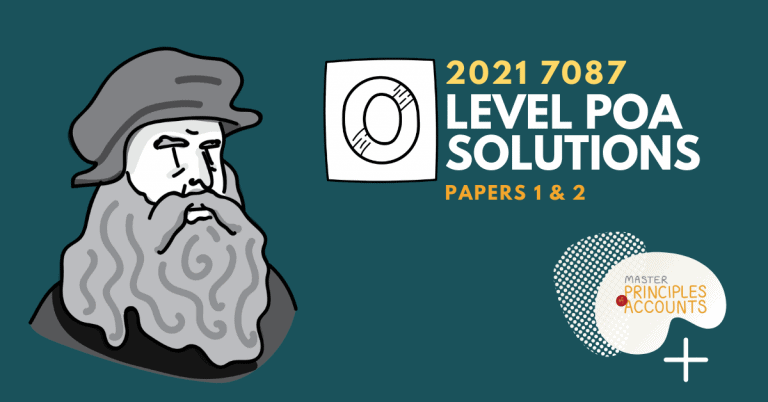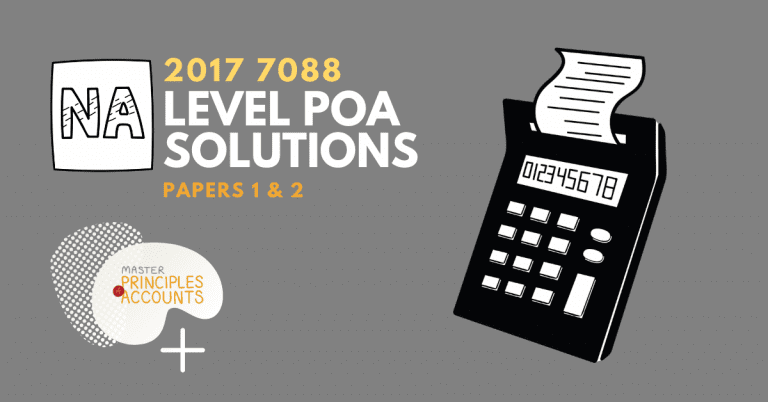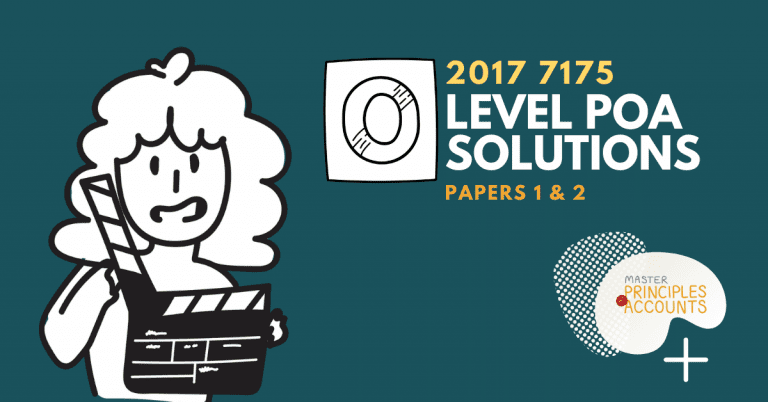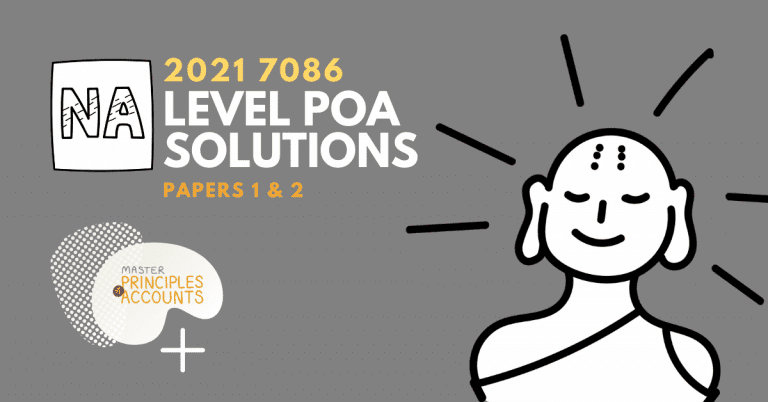2021 O Level POA Answers
Paper 1 :
a) To allow segregation of duties
b) 1 – Flexibility 2 – Reduction in mistakes
ci) – $150
cii) – $55
d) It states that every transaction must be supported by a source document that is verifiable.
e) Payment voucher/Invoice/Receipt
f) It states that the accountant must be straightforward and honest in the recording of all business transactions.
a) Accrual theory. It states that revenue is recognized when it is earned, regardless of when it was received.
b)
| Particulars | Dr $ | Cr $ |
| Consultancy fee receivable | 2800 | |
| Consultancy fee | 2800 | |
| Being adjustment for commission fee receivable at year end |
c)
Consultancy Fee Income
| Date | Particulars | Dr $ | Cr $ | Bal $ |
| 2021 | ||||
| Mar 31 | Cash at bank | 62,220 | 62,220 | |
| Commission receivable | 2,800 | 65,020 | ||
| Profit and loss (income summary) | 65,020 |
d) sales journal
- Calculate, for the year ended 31 January 2021:
(i) Total sales revenue:
Percentage of expense = Expense/Net sales revenue x 100% = 35%
35% (expense) -> $28,000
100% (net sales revenue) = $28,000/35*100 =$80,000
Net sales revenue = total sales revenue – sales returns
$80,000 = Total sales revenue – 3500
Total sales revenue = $83 500
(ii) total credit sales:
100% -> $83 500.
Credit sales = 100% – 45% = 65%
Total credit sales = 0.55*83500 = $45 925
(iii) Cost of sales:
Net sales revenue – Cost of sales – expenses = Profit
$80,000 – Cost of sales – 28,000= 5600
Cost of sales=$46,400
b)
Double entry rule: Every business transaction is recorded using the double-entry recording. Every transaction will have at least one debit entry to one account and at least one credit entry to another account.
> The total debit value must equal to the total credit value for each transaction
c)
Two uses of trial balance:
1. To facilitate the preparation of financial statements
2. To check for arithmetical errors in recording of the transactions
d)
Stakeholders- Government/Employees/Shareholders/…
Reason for interest: Government – to know how much tax should they collect from the business
a)
| 31 July 2020 | 31 July 2021 | |
| Workings | (9785+8325)÷ 2= 9055 | (8325+78054)÷ = 8065 |
| Inventory turnover rate (times) | 68,000÷9055=7.50966 =7.51(2.d.p) | 65,000÷8065=8.0595 =8.06(2d.p) |
b) The rate of inventory turnover for mia’s business has improved from 7.51 times in 2020 to 8.06 times in 2021. This indicates that the business is not able to manage it’s inventory efficiently over the years.
c)
Suggest one measure a business can take to improve the rate of inventory turnover
•Review the types of goods sold so as to improve sales volume
Organize sales promotion to increase sales volume
•Review the quality of services provided in order to improve the sale volume “
•Increasing sales by attracting more customers through advertising and marketing.
Reducing selling prices for slower moving items.
•Offering discounts and special promotions to encourage customers buying in bulk or make frequent purchases.
•Decreasing inventory on hand by keeping just sufficient goods to meet customers’ demands and not holding excessive inventory.
•A business can sell more by using advertisements to attract customers or offer sales promotions and discounts.
d)
Statement of financial position as at 31 July 2021 (extract)
| Current asset | $ | $ |
| Inventory | 600 |
Paper 2 :

Michelle
Income statement for the year ended 30 September 2021
| $ | $ | |
| Sales revenue | 97,200 | |
| Less: Sales returns | (3400) | |
| Net sales revenue | 93,800 | |
| Less: Cost of sales(58300-420) | 57,880 | |
| Gross profit | 35920 | |
| Other income | ||
| Discount received | 1400 | |
| Less: Other expenses | ||
| Impairment loss on trade receivables | 450 | |
| Depreciation of fixtures and fittings(10%x33000) | 3300 | |
| Depreciation of motor vehicles [(24000-10500) x 25%] | 3375 | |
| Interest | 600 | |
| General expense(8110+185) | 8295 | |
| Wages and salaries | 15700 | |
| Discount allowed | 1875 | |
| Rent expense (11250-2250) | 9000 | 42595 |
| Loss for the period | 5275 |

Michelle
Balance sheet as at 30 September 2021
| $ | $ | $ | |
| Non-current assets | Cost | Accumulateddepreciation | Net book value |
| Fixtures and fittings | 33000 | 13200 | 19800 |
| Motor Vehicles | 24000 | 13875 | 10125 |
| 29925 | |||
| Current assets | |||
| Inventory | 9750 | ||
| Trade receivables | 10820 | ||
| Less: Allowance for impairment of trade receivables (700-250) | (700) | ||
| Net trade receivables | 10120 | ||
| Prepaid rent expense | 2250 | ||
| Cash at bank | 3200 | ||
| Total Assets | 55245 | ||
| Equity & Liabilities | |||
| Owner’s equity | |||
| Beginning Capital(-5800-420-5275) | 47615 | ||
| Less: Loss for the year | (5275) | ||
| Less: Drawings | (6220) | 36120 | |
| Non-current liabilities | |||
| Long-term borrowings | 10000 | ||
| Current liabilities | |||
| Trade payables | 8340 | ||
| General expense payable | 185 | ||
| Accrued interest expense | 600 | 9125 | |
| Total equity and liabilities | 55245 |

(a) The value of owner’s equity changes when there’s contribution of assets by its owner, profit and losses in a year and owner’s drawing of resources from the business for personal use.
(b) Profit = Ending capital + drawings – beginning capital.
35,000 = (105,000+16,000+11,000+2250-29000-3250-32000) + Drawings – 55,000
35,000=70,000 + Drawings -55,000
Drawings = 35,000+55,000-70,000
=$20,000
(c) Dr Capital 6100, Cr Drawings 6100
(d) CLT.

(a)
Journal
| Date | Particulars | Dr | Cr |
| 2020 | $ | $ | |
| May | Allowance for impairment of trade receivables | 2100 | |
| Trade receivables – Ami | 2100 |
(b) The business allocates a portion of trade receivables as allowance for impairment of trade receivables as debts that are likely to be uncollectible, this is to ensure that the business does not overstate its assets in accordance to prudence theory.
(c)
Allowance for impairment of trade receivables account
| Date | Particulars | Dr | Cr | Balance |
| 2020 | $ | $ | $ | |
| June 1 | Balance b/d (2100+4200+3520) | 9820 Cr | ||
| 2021 | ||||
| May 31 | Trade receivables – Ami | 2100 | 7720 Cr | |
| Trade receivables – Eugene | 2200 | 5520 Cr | ||
| Impairment loss on trade receivable | 5520 | 0 |
(d) Impairment loss on trade receivables will be recorded as an expense.
(e) Evaluate:
He can evaluate the likelihood based on the fact that he is in the second year of business and has a history of the payment behavior of his customers. He should also do so to follow the prudence concept and avoid overstating assets by recording allowance for impairment on trade receivable should some credit customer be unable to pay in near future.

(a)
Trade payable – Chang
| Date | Particulars | Dr | Cr | Balance |
| 2021 | $ | $ | $ | |
| Feb 8 | Inventory | 3500 | 3500 Cr | |
| Feb 12 | Inventory | 500 | 3000 Cr | |
| Feb 16 | Inventory (90% x 6000) | 5400 | 8400 Cr | |
| Feb 21 | Cash at bank (98%x 8400) | 8232 | 168 Cr | |
| Discount received (2%x 8400) | 168 | – |
(b) Trade discount is given to encourage bulk purchase
Trade discount is given at the point of sale
Cash discount is given to encourage early/prompt payment
Cash discount is given at the point of payment
(c) The financial statement of a trading business includes the sales revenue, sales returns and cost of sales account while a service business does not have a trading account and starts its financial statements with a service fee revenue account.
(d) The accounting period theory divides the life of a business into equal time periods for financial reporting.
- Non current assets are assets owned and controlled by the business and bought for the business use to generate income. It is not meant for resale.
i) Depreciation is the allocation of the cost of non-current asset over its useful life
ii) Accumulated depreciation refers to the total depreciation of a non-current asset to date.
(c) Prudence and matching concept
Note: Consistency concept is not appropriate. This concept is for the use of the same depreciation methods across accounting periods.
(d) Gain or Loss on Sale of NCA:
Net book value of nca = 80%*80%*30,000 = $19,200
Sold for $15,000. Loss on sale of non-current asset = $19,200 – $15,000 = $4,200.
(e) Dr Cash at bank 15,000 Cr SALE OF NON- CURRENT ASSET
Note: It’s not credit Motor Vehicle. See page 54 of MPOA study guide for explanation.


